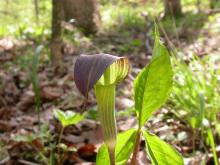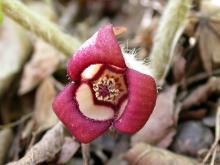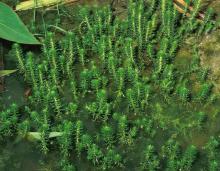Wildflowers, Grasses and Other Nonwoody Plants
Media

Species Types
Scientific Name
Arisaema triphyllum
Description
Preacher Jack in his “pulpit” is sheltered by the canopylike spathe, which is green with white and brown lengthwise markings. An unforgettable spring wildflower, Jack-in-the-pulpit is common throughout the state.
Media

Species Types
Scientific Name
Asarum canadense
Description
In spring, wildflower lovers locate wild ginger by looking for its unique, hairy, heart-shaped leaves, then by stooping to view the small, three-parted brown flowers that form between the leaf bases, close to the ground.
Media

Species Types
Scientific Name
Myriophyllum spp.
Description
Water milfoils are feathery aquatic plants that grow rooted in shallow water. Their tips emerge above the waterline and bear bladelike, toothed leaves.
Media

Species Types
Scientific Name
Triosteum perfoliatum
Description
Even without its flowers, or its fruits that resemble miniature oranges, common horse gentian is notable for its opposite leaves, which are broadly fused together at the bases and almost appear as a single leaf with a stem going through it.
Media

Species Types
Scientific Name
Matelea decipiens
Description
The brown, starlike, spreading flowers of climbing milkweed differ from those of other milkweeds, but milky sap, warty pods with silk-tasseled seeds, and the structures in the center of the flowers show its true alliance.
Media

Species Types
Scientific Name
Helianthus spp.
Description
Most people recognize sunflowers when they see them, with their bright yellow ray flowers and rather flattened center of dark disk flowers. There are 16 species of Helianthus in Missouri.
Media

Species Types
Scientific Name
Scrophularia marilandica
Description
Eastern figwort occurs statewide in rich woods, woodland borders, and bottomlands. It’s usually 2-5 feet high, has square stems and lance-shaped, toothed leaves, and bears spreading clusters of small, green scoop-shaped flowers with brown petal lobes.
See Also
About Wildflowers, Grasses and Other Nonwoody Plants in Missouri
A very simple way of thinking about the green world is to divide the vascular plants into two groups: woody and nonwoody (or herbaceous). But this is an artificial division; many plant families include some species that are woody and some that are not. The diversity of nonwoody vascular plants is staggering! Think of all the ferns, grasses, sedges, lilies, peas, sunflowers, nightshades, milkweeds, mustards, mints, and mallows — weeds and wildflowers — and many more!





















